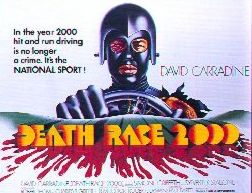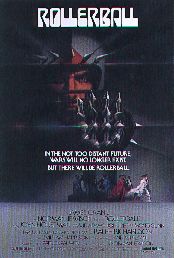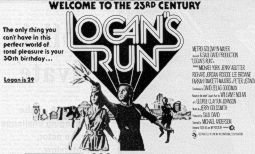
FUTURISTIC DYSTOPIAS


One of my favourite film genres is what you could call the 'futuristic dystopia', unless someone has invented a less cumbersome name for it. This genre seemed to be one of the most prominent of the 1970s, along with road movies and disaster movies. What's interesting is that sci fi films of previous decades, where space exploration was purely fantasy, were either eager to anticipate a Jetsons-style future full of gadgets and silver surfaces (see also 1950s interior design) or simply transplant the Wild West and swashbuckling genres into the galaxy; whereas the sci films of the '70s hit a more pessimistic note.
The seventies was like a bad hangover after a wild party, as the revolution failed to be televised. The best minds of the baby boomer generation either burnt out or sold out, the war in Viet Nam continued to drag on, the Watergate scandal erupted, and in the UK things were no better, with recession, oil shortages, three-day weeks, British Leyland strikes every other week - A Clockwork Orange, the only British-made film I'm looking at, with its high rise urban wastelands and dandyish bullyboys provided a visual motif for the punks to pillage.
This is the background that informed the 'futuristic dystopias' of '70s sci fi (not just in cinema either - see JG Ballard's books High Rise and Crash). This split into two sub-genres. The first, taking its cue from 2001, used outer space as a metaphor for inner space, astronauts retreating from the world into alienation like Major Tom, the anti-hero of David Bowie's "Space Oddity", recorded in 1969 and a UK number one in 1975. Three early '70s sci fi films show spacemen turning their back on Earth and turning on, tuning in and dropping out - John Carpenter's Dark Star, Silent Running (directed by Douglas Trumbull, who worked on 2001) and the Russian film Solaris.
 In the splendidly low-budget Dark Star, three astronauts bicker, eat tasteless synthetic meals against a background of mind-numbing muzak; and the ship computer keeps having to talk an independently-minded talking bomb out of detonating itself. The astronauts all have long hair and one of them tries to get back to Earth on his surfboard, giving the film a kind of 'Easy Rider in space' feel. Silent Running is even more hippyish, with Bruce Dern maintaining the world's only surviving flora in a huge orbital biosphere. When the order is given to destroy the project, he jettisons the crew and retires in his artifical Eden, presumably with some Joni Mitchell 8-track cartridges. The Russian film Solaris presents both alternatives of the future: an ultra-urbanised Earth and a rural idyll, in the form of an intelligent planet (Solaris) that can create any desired scenario, and the scientist Kelvin - who has been sent to investigate Solaris - chooses the rural idyll.
In the splendidly low-budget Dark Star, three astronauts bicker, eat tasteless synthetic meals against a background of mind-numbing muzak; and the ship computer keeps having to talk an independently-minded talking bomb out of detonating itself. The astronauts all have long hair and one of them tries to get back to Earth on his surfboard, giving the film a kind of 'Easy Rider in space' feel. Silent Running is even more hippyish, with Bruce Dern maintaining the world's only surviving flora in a huge orbital biosphere. When the order is given to destroy the project, he jettisons the crew and retires in his artifical Eden, presumably with some Joni Mitchell 8-track cartridges. The Russian film Solaris presents both alternatives of the future: an ultra-urbanised Earth and a rural idyll, in the form of an intelligent planet (Solaris) that can create any desired scenario, and the scientist Kelvin - who has been sent to investigate Solaris - chooses the rural idyll.
 The more prominent sub-genre, and the one that interests me the most, is the other alternate vision of the future. Here we see exactly what Major Tom and the crew of Dark Star were leaving behind - a vision of a post-apocalyptic society "in the not too distant future". This phrase is often used to describe films that are basically a satirical exaggeration of how we live now under the guise of sci fi. Society is divided amongst the haves and the have-nots, and the film's poster slogans suggest a pleasuredome that has bought into pure hedonism at a price - "The only thing you can't have in this perfect world of total pleasure is your 30th birthday" (Logan's Run), "In the year 2000, hit and run driving is no longer a crime...it's the national sport!" (Death Race 2000)
The more prominent sub-genre, and the one that interests me the most, is the other alternate vision of the future. Here we see exactly what Major Tom and the crew of Dark Star were leaving behind - a vision of a post-apocalyptic society "in the not too distant future". This phrase is often used to describe films that are basically a satirical exaggeration of how we live now under the guise of sci fi. Society is divided amongst the haves and the have-nots, and the film's poster slogans suggest a pleasuredome that has bought into pure hedonism at a price - "The only thing you can't have in this perfect world of total pleasure is your 30th birthday" (Logan's Run), "In the year 2000, hit and run driving is no longer a crime...it's the national sport!" (Death Race 2000)
 The haves live in a brave new world of synthetic pleasures (eg Logan's Run, where laser cosmetic surgery is the norm, and you can pick sexual partners from an interactive matrix; Westworld, a robotic amusement park where tourists can fight robot gunslingers and, yes, even sleep with the robot whores) and super-intelligent computers that make 2001's Hal look like a toaster. (See Demon Seed, where Julie Christie's house is run by an omniscient computer that eventually impregnates her! Neat trick if you can pull it off...)
The haves live in a brave new world of synthetic pleasures (eg Logan's Run, where laser cosmetic surgery is the norm, and you can pick sexual partners from an interactive matrix; Westworld, a robotic amusement park where tourists can fight robot gunslingers and, yes, even sleep with the robot whores) and super-intelligent computers that make 2001's Hal look like a toaster. (See Demon Seed, where Julie Christie's house is run by an omniscient computer that eventually impregnates her! Neat trick if you can pull it off...)
The have-nots live in urban wastelands with population problems and major food and energy shortages (eg Soylent Green), gangs of youths run amok among the streets and tower blocks like packs of dogs (A Clockwork Orange, The Warriors); and an underclass are kept dumb and unquestioning by media propaganda and dubious bloodsports-style entertainment (eg Death Race 2000, Rollerball - see also The Running Man).
 Quite a few of these films do not strictly fall under the sci fi genre. For example, Assault On Precinct 13, The Warriors and A Clockwork Orange do not boast any cliched sci fi trappings such as lasers and gadgets and are not set in any specific decade, but all seem to take place sometime between 1980 and the mid twenty-first century. These three films define the urban wasteland look, concrete jungles that the 2001 generation have abandoned and forgotten about and left their proto-punk offspring to fend for themselves. Dilapidated high rises and graffitied subways and desolate streets littered with abandoned or burnt out cars feature heavily.
Quite a few of these films do not strictly fall under the sci fi genre. For example, Assault On Precinct 13, The Warriors and A Clockwork Orange do not boast any cliched sci fi trappings such as lasers and gadgets and are not set in any specific decade, but all seem to take place sometime between 1980 and the mid twenty-first century. These three films define the urban wasteland look, concrete jungles that the 2001 generation have abandoned and forgotten about and left their proto-punk offspring to fend for themselves. Dilapidated high rises and graffitied subways and desolate streets littered with abandoned or burnt out cars feature heavily.
Two other non-sci fi films that deserve to be mentioned are Wild In The Streets and Dawn Of The Dead. Wild In The Streets was made in 1968 and based on a novel by Robert Thom, who also wrote Death Race 2000, and is a counter-culture satire where a teenager becomes president, puts LSD in the tap water, and sends adults aged over 25 to concentration camps. Freaky! Dawn Of The Dead is the middle part of George Romero's classic zombie trilogy, and arguably the finest of the trio. Again, set in what appears to be the near future, where the country is in a state of national emergency and run by a paramilitary organisation dealing with the threat of the dead coming back to life, whittling down the population. Most of the action takes place in a multi-storey-shopping arcade, where a small group of survivors are holed up, and pick off zombies that stumble around the mall in a grotesque parody of their former behaviour - walking up the down escalators, milling around the water fountains etc. As satire goes, it's not exactly subtle, but is handled very humorously, and the phrase mindless consumerism never seemed so literal!
 These films have great soundtracks - Andre Previn's futuristic lounge muzak of Rollerball, Walter Carlos's Moog Beethoven score for A Clockwork Orange, John Carpenter's lo-fi electronica scores for his films Assault On Precinct 13 and Dark Star - and some wonderfully kitsch space-age leisureware. However, what I love most of all about these films is, now we have passed the two milestone dates of 1984 and 2001, it only takes a small stretch of the imagination to see how prophetic these films are.
These films have great soundtracks - Andre Previn's futuristic lounge muzak of Rollerball, Walter Carlos's Moog Beethoven score for A Clockwork Orange, John Carpenter's lo-fi electronica scores for his films Assault On Precinct 13 and Dark Star - and some wonderfully kitsch space-age leisureware. However, what I love most of all about these films is, now we have passed the two milestone dates of 1984 and 2001, it only takes a small stretch of the imagination to see how prophetic these films are.
I mean, Death Race 2000 and Rollerball use exploitative reality TV game shows as entertainment, keeping the populace distracted from the decay around them. OK, Big Brother and Survivor haven't yet resorted to running over contestants yet, but I think you can see where I'm going with this. My personal favourite is Logan's Run, a pleasure-seeking metropolis which looks uncannily like a massive shopping arcade, and all its inhabitants have flawless cheekbones and no one seems to be over thirty! Of course, "it's only a movie..."
 FILMOGRAPHY
FILMOGRAPHY
"THX 1138" (1970, dir. George Lucas)
"A CLOCKWORK ORANGE" (1971, dir. Stanley Kubrick)
"THE OMEGA MAN" (1971, dir. Boris Sagal)
"SILENT RUNNING" (1971, dir. Douglas Trumbull)
"SOLARIS" (1971, dir. Andrei Tarkovsky)
"SLEEPER" (1973, dir. Woody Allen)
"SOYLENT GREEN" (1973, dir. Richard Fleischer)
"WESTWORLD" (1973, dir. Michael Chrichton)
"DARK STAR" (1974, dir. John Carpenter)
"DEATH RACE 2000" (1975, dir. Roger Corman)
"ROLLERBALL" (1975, dir. Norman Jewison)
"ASSAULT ON PRECINCT 13" (1976, dir. John Carpenter)
"FUTUREWORLD" (1976, dir. Richard T. Heffron)
"LOGAN'S RUN" (1976, dir. Michael Anderson)
"DEMON SEED" (1977, dir. Donald Cammell)
"THE WARRIORS" (1979, dir. Walter Hill)
Pictures taken from Film Posters of the 70s, edited by Tony Nourmand and Graham Marsh (Aurum Press, 1998)
Additional information taken from The Ultimate Encyclopedia of Science Fiction, edited by David Pringle (Colour Library Direct, 1997)